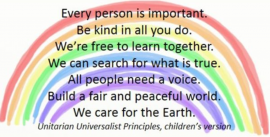Faith Formation: At-Home Resources
Our Monthly Themes and Curriculum in Children's Faith Formation
UUCR Family Faith Formation follows the same monthly spiritual themes that shape our worship, music, and small group ministry. This thematic approach connects faith development across the whole congregation and provides a bridge for parents and children to share conversations after class. Whether your child is participating online only or has simply missed the in-person class, we hope that these resources might enrich your family life and help you to form deeper connections.
Theme: Renewing Faith
Preparing the Renewing Faith Theme for Parents and Caregivers
A UU Take on Faith
Questions for Reflection for Adults
- What is faith to you?
- What and who do you have faith in?
- How do you sustain, renew, and live your faith? What practices, places and people support and inspire you to stay centered in that which matters most to you?
- What do you hope for your child as they develop their own faith perspective?
Renewing Faith Music
Children's Renewing Faith Lessons
Renewing Faith in Promises
Renewing Faith in Ourselves
Renewing Faith in Each Other
Renewing Faith in the Simple Things
We may not do these sessions in order, or complete all the sessions in our class time.
Lesson A : Renewing Faith in Promises
Children's Activities
Story to Read or Watch: The Promise by Nicola Davis A story about a promise to plant acorns in a city that transforms the neighborhoods as well as the planter.
The Rainbow is a Symbol of Faith
What promises does the rainbow represent?
- a promise of hope after a storm as the sun shines through again, and a reminder of the beauty in nature
- the biblical covenant between God and Noah that the earth would not be destroyed. Here's a fun version of this short story about Noah and the Rainbow Covenant.
- the promise of the PRIDE flag to honor the LGBTQIA community and the pride in being their true selves
- the seven colors of the rainbow are also a symbol of the seven UU Principles, our promises to each other and to ourselves. (But now we have 8 principles at UUCR! Learn more below.)
One of our UU Sources of learning about faith is Science. When and where have you seen rainbows? Do you know what causes them to appear? Understanding the science of rainbows can make them that much more fabulous to see! Check out National Geographic's website for rainbow facts!
Family Activities for All Ages
Create a Family Covenant!
What are some promises that your family makes to one another? Are they spoken or unspoken? Written or unwritten?
Do you think that you all agree what is most important to you as a family?
One way we live our faith in self and others is through making and keeping promises of how we will treat each other.
Making a "Family Covenant" of promises to one another in your family can help you remember how you want to show your caring to each other every day.
Choose approximately 5 promises that all members of the family will strive to keep. For example: respect people's differing needs, speak kindly, listen attentively, all feelings are valid, every person matters.
Plant seeds or a tree together!
Plant In your yard, or as part of a volunteer project. How can you have faith that it will grow? Do you believe this will only happen given the right conditions? How are our own actions part of being "faithful?"
Renewing Faith in Each Other by Joining Forces
Story: A Bundle of Sticks
Tell the story, A Bundle of Sticks, adapted from an Aesop's fable. read it with your child, or have them read it to you. Talk about it, during and after you tell it.
- Why did the mother want her children to be friends to one another?
- Have you ever needed friendship or help from your siblings or friends?
- How do your parents rely on siblings, family members and others to support them and keep them strong?
- Do you think that these adult siblings will be able to join together like their mother hoped when she showed them the bundle of sticks?
- What is the lesson in this story?
- Do you think this lesson is true?
Family Activities
- Bake or cook together
- Build something with blocks or other materials together
- Do a puzzle together
- Build a structure out of cardboard boxes & other recyclable materials and tape, glue.
- Play a cooperative board game- Use one you have at home, or adapt a competitive board game to become cooperative! Hoot, Owl, Hoot is my favorite cooperative game in which everyone tries to get the baby owls to their nest. It’s available at many online retailers, along with other cooperative board games ( inc. Stone Soup and Count Your Chickers) by Peaceable Kingdom. Fun for ages 4 and up, including adults. The website of the Enrichment Alliance of Virginia contains ideas for adapting your current games, like "Cooperative Candyland." With older kids, try Cooperative Scrabble or Cooperative Monopoly! Not only do these create an atmosphere of alliance, they are a great work-around for the child who hates to lose!
- lifelong spiritual discovery
- beloved community
- a just world





